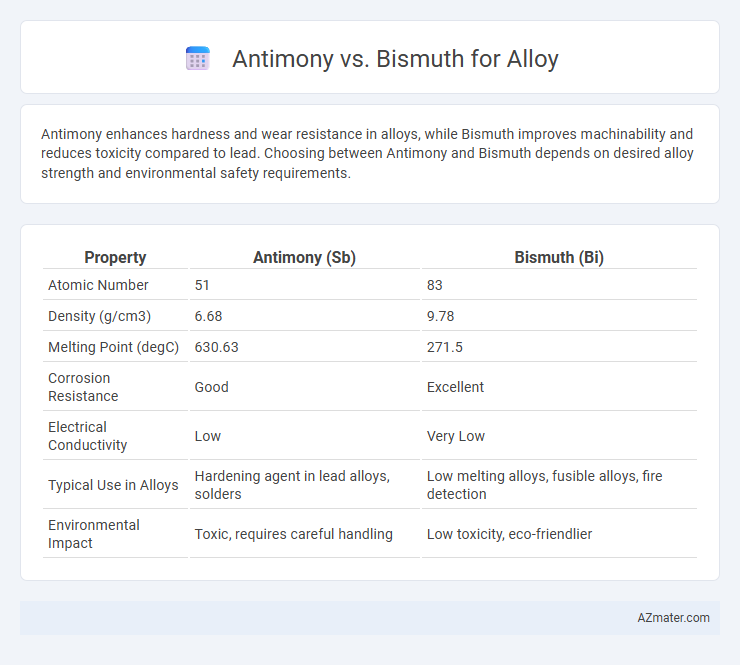Antimony enhances hardness and wear resistance in alloys, while Bismuth improves machinability and reduces toxicity compared to lead. Choosing between Antimony and Bismuth depends on desired alloy strength and environmental safety requirements.
Table of Comparison
| Property | Antimony (Sb) | Bismuth (Bi) |
|---|---|---|
| Atomic Number | 51 | 83 |
| Density (g/cm3) | 6.68 | 9.78 |
| Melting Point (degC) | 630.63 | 271.5 |
| Corrosion Resistance | Good | Excellent |
| Electrical Conductivity | Low | Very Low |
| Typical Use in Alloys | Hardening agent in lead alloys, solders | Low melting alloys, fusible alloys, fire detection |
| Environmental Impact | Toxic, requires careful handling | Low toxicity, eco-friendlier |
Introduction to Antimony and Bismuth in Alloying
Antimony and Bismuth are crucial alloying elements known for enhancing metal properties such as hardness, strength, and corrosion resistance. Antimony is commonly used in lead alloys for batteries, cable sheathing, and type metals due to its ability to increase tensile strength and improve casting qualities. Bismuth, favored for its non-toxicity and low melting point, serves as a substitute for lead in alloys applied in plumbing, fire detection, and low-melting solders, offering improved environmental safety without compromising performance.
Chemical Properties: Antimony vs Bismuth
Antimony (Sb) and Bismuth (Bi) both belong to the pnictogen group, but antimony exhibits higher hardness, thermal stability, and better oxidation resistance, making it suitable for strengthening alloys. Bismuth, with a lower melting point (271degC) and brittle nature, provides excellent machinability and non-toxicity but has poor corrosion resistance compared to antimony. The difference in electronic configurations--antimony's 5s2 5p3 versus bismuth's 6s2 6p3--affects their chemical reactivity, influencing alloy characteristics like electrical conductivity and tensile strength.
Alloy Compatibility and Popular Uses
Antimony enhances hardness and corrosion resistance when alloyed with lead, making it essential in battery grids, bearings, and ammunition manufacturing. Bismuth, valued for its low toxicity and machinability, is widely used in alloys for plumbing, fire detection systems, and environmentally-friendly replacement for lead. Both elements improve alloy performance, but antimony's compatibility suits heavy-duty applications, while bismuth is preferred in non-toxic, precision-use alloys.
Mechanical Strength and Hardness Comparison
Antimony enhances alloy hardness and tensile strength more effectively than bismuth due to its ability to form solid solutions and intermetallic compounds that improve load-bearing capacity. Bismuth alloys typically exhibit lower mechanical strength but offer excellent machinability and thermal conductivity, making them suitable for applications where ease of fabrication is critical. The presence of antimony in lead-based alloys increases Vickers hardness significantly, whereas bismuth contributes to brittleness without comparable improvements in mechanical durability.
Melting Points and Casting Behavior
Antimony has a melting point of about 630.6degC (1167degF), making it suitable for alloys requiring moderate melting temperatures, while bismuth melts at a lower temperature of 271.5degC (520.7degF), enabling alloys to cast at comparatively lower temperatures. Antimony enhances hardness and wear resistance in alloys but can increase brittleness during casting, whereas bismuth contributes to improved fluidity and fine grain structure, reducing shrinkage defects in castings. Alloys containing bismuth typically exhibit better casting behavior with reduced porosity and smoother finishes compared to those with higher antimony content.
Corrosion Resistance in Alloys
Antimony enhances corrosion resistance in alloys by forming a protective oxide layer that prevents degradation in harsh environments, making it valuable in lead-acid batteries and soldering metals. Bismuth offers moderate corrosion resistance but is primarily valued for its low toxicity and machinability rather than protective properties in alloys. For applications requiring superior corrosion resistance, antimony-containing alloys outperform bismuth alloys due to their stability and ability to resist oxidative damage.
Environmental and Health Considerations
Antimony and bismuth, commonly used in alloys, differ significantly in environmental and health impacts. Antimony is toxic and poses risks such as respiratory issues and environmental contamination through mining and processing. Bismuth offers a safer alternative with low toxicity and minimal environmental hazards, making it preferable in applications prioritizing sustainability and human health.
Cost Analysis: Antimony vs Bismuth
Antimony remains significantly more cost-effective than bismuth, with average prices around $8 per kilogram compared to bismuth's $20 to $30 per kilogram. The lower cost of antimony primarily drives its preference in mass-produced alloys used in automotive and battery applications. However, bismuth's environmental benefits and non-toxicity justify its higher price in specialized uses where regulatory compliance and sustainability are prioritized.
Performance in Common Applications
Antimony enhances alloy hardness and corrosion resistance, making it ideal for lead-acid batteries, solder, and type metal applications. Bismuth improves alloy machinability and environmental safety due to its non-toxicity, often replacing lead in plumbing and casting alloys. In common applications, antimony alloys excel in durability and heat resistance, while bismuth alloys offer safer handling and better thermal expansion control.
Choosing the Right Metal: Key Takeaways
Antimony enhances alloy hardness and wear resistance, making it ideal for lead-based alloys used in batteries and bearings, while bismuth offers superior thermal expansion compatibility and non-toxic properties, preferred in low-melting alloys and medical applications. Selecting antimony improves mechanical strength and corrosion resistance, whereas bismuth is chosen for environmentally friendly, lead-free alternatives. Consider the application's temperature requirements and toxicity regulations to determine the optimal choice between antimony and bismuth in alloy formulation.

Infographic: Antimony vs Bismuth for Alloy
 azmater.com
azmater.com